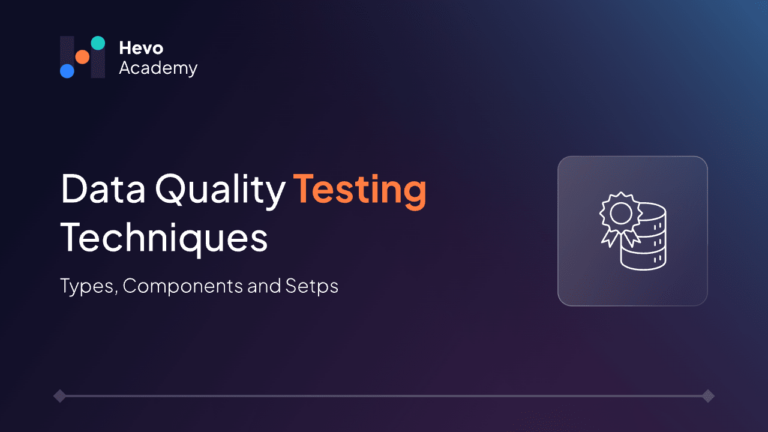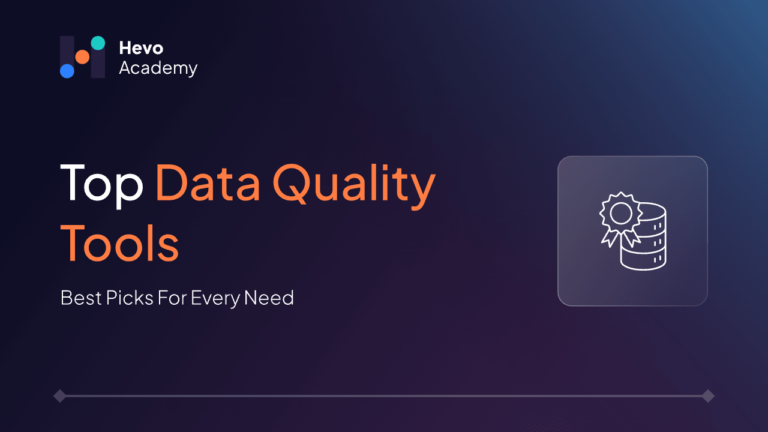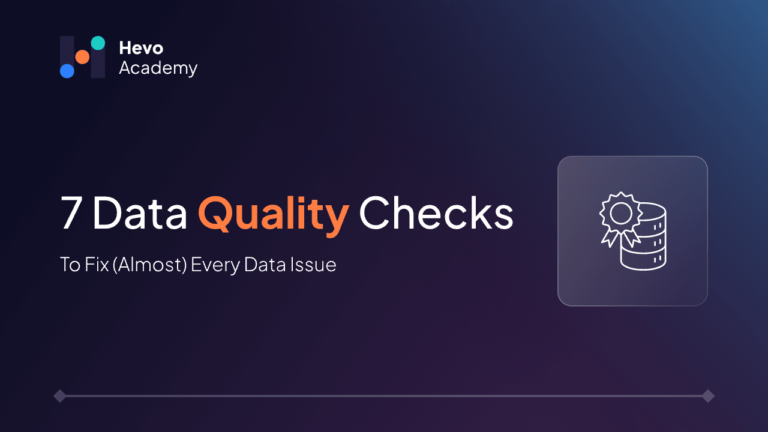In this modern data world, where decisions are made based on the reliability of the data, Data Quality testing emerges as an important check to be carried out in almost every industry. Data is the backbone of any organization that makes data-driven decisions, and it helps them generate day-to-day business insights as well as long-term decisions.
Table of Contents
Poor data quality can produce wrong insights and decisions, and sometimes, organizations may face legal penalties, thereby putting a business at risk.
This blog post will discuss data quality testing, its importance, tests, and best practices for tracking data quality.
What is Data Quality Testing? And Why is it Important?
Data Quality Testing (DQT) is a process that performs various checks against the data using pre-defined business rules or quality metrics. This test ensures that the data is suitable for its intended purpose. With the help of a Data Quality testing framework, one can perform checks against the data at various stages, such as ingestion, collection, migration, and transformation.
Data quality testing is essential for ensuring that your data is clean, consistent, and trustworthy. With Hevo, you can take your data quality testing to the next level by:
- Automating data integration across 150+ sources, ensuring seamless connection and eliminating manual checks
- Identifying and correcting data inconsistencies in real-time, so your teams always work with up-to-date and accurate data
- Delivering accurate insights that empower smarter decision-making, driving better business outcomes
Trusted by industry leaders like Postman, and Whatfix, Hevo makes data integration effortless and scalable. Ensure your data is always accurate, consistent, and actionable with Hevo today!
Get Started with Hevo for FreeWhat are the Types of Tests for Data Quality Testing?
Effective data quality testing involves multiple tests that evaluate different aspects of data quality. Here are some of the common tests used in Data Quality Testing.
1. Null Value Test
Null values refer to missing or empty data in a dataset, which may drastically impact the analysis. Null value testing identifies the record where data is missing or null.
Example:
- In the medical world, if essential patient information, such as name, medical history, prescription, etc., is missing, it will cause errors in treatment.
- In an e-commerce system, if essential customer information like email, address, and phone numbers is missing, the entire sales process will be impacted.
2. Numeric Distribution Test
Numerical distribution tests determine whether numerical data (e.g., integers, floats, decimals, etc.) match the expected pattern or fall within logical ranges. These tests help catch outliers and anomalies indicating data entry or operation errors.
Example:
- Prices on an e-commerce platform should be reasonable and accurate. Listing an item as $0 or $1,000,000 may indicate an error.
- A sales dashboard reporting unusually high or low sales figures due to data entry errors will provide misleading insights into performance.
3. Volume Test
Volume Test checks how much data has been processed and against standards. An unexpected increase or decrease in the data indicates missing or duplicate data.
Example:
- A significant drop in daily transactions could indicate an issue with the data collection process.
- If a system is expected to ingest 10000 rows per day, and then there is suddenly a spike of 50000 records, it indicates an issue with data collection or failure in the upstream.
4. Uniqueness Test
A uniqueness test checks that the specific data points, such as primary keys or unique keys, are unique, i.e., occur at most once within the datasets. This test ensures that the data is free from duplicates, which may cause issues in downstream applications.
Example:
- In a customer database, each customer ID should be unique. Duplicate IDs may cause data integrity issues.
- In a financial system, duplicate transaction IDs may cause double-counting revenue or expenses.
5. String Test
String tests are used to validate string fields in a dataset. This test checks for format errors, special characters, or strings that don’t match the expected patterns.
Example:
- A typical example of a string test is the email field. Email should follow a specific pattern. A string test can identify email addresses with incorrect formats (e.g., missing “@” symbol) or unwanted characters.
6. Source Data Validation
Source data validation ensures that the data being imported from external systems matches the expected format and value. This test is used when multiple source systems are involved.
Example:
- To avoid discrepancies, the financial system that pulls data from the sales process must confirm that the data format and price (e.g., currency and date format) are consistent with expectations.
7. Completeness Verification
Completeness verification checks whether the data set contains all required data points. Any missing data can lead to incomplete or misleading analysis and affect decision-making.
Example:
- If the data is missing sales data for certain products, it can lead to inaccurate forecasting and resource allocation.
8. Freshness Checks
The freshness check ensures that the data used for analysis is recent/new and contains up-to-date information. This test is especially important where time series analysis is required. Outdated data can lead to wrong insights.
Example:
- A stock platform needs fresh data to display accurate prices.
- A real-time fraud detection system requires up-to-date data to identify potentially fraudulent activities.
9. Referential Integrity Tests
Referential integrity tests ensure that relationships between tables or datasets are maintained. These tests check if foreign keys are correctly mapped to primary keys in related tables.
Example:
- An order should have a valid customer in an e-commerce database. If the customer ID in the order table doesn’t match any customer in the customer table, it is a referential integrity violation.
What is the Optimal Timing for Data Quality Testing?
It is important to conduct data quality audits on time to identify and resolve problems before they affect the process and analysis. There are three important areas for data quality testing:
- During Pull Requests: When changes are made to existing data pipelines or data-related code (e.g., adding new data sources or adding change logic), a data quality check is required as part of the pull request process to ensure these changes will not cause additional data problems.
- In Production: Data quality testing is a continuous process, and it should be carried out in every environment, even Production. As we know, the data in production is real and has lots of dynamics, so we should perform DQT in the production environment. By performing Data Quality testing in the production environment, we can minimize the risk of corrupted data, data integrity issues, and more.
- During Data Transformations: Data in the data pipeline typically undergoes multiple transformations (e.g., data collection, data filtering, or data merging), and that may introduce errors if the data is improperly handled. Data quality checks should be performed at each transformation step to ensure data continuity and accuracy throughout the pipeline.
Key Components of Data Quality Testing
Data quality testing involves several critical components to ensure the process is effective and error-free. The key components of Data Quality Testing are as follows –
- Data Checks at Entry point (Start Node)
The entry point of the data in the system is the critical point as it is the stage where data enters into the system from multiple sources. Data Quality checks should be performed at this stage to address the critical points. For example –
- Is the address correct
- Is the email in valid format
- Primary keys are not null
- Dates, Currency is in the expected format, etc.
- Test Case Design
A proper detailed test case is essential for Data Quality testing. By designing the test case for Data Quality Testing one has to ensure that it has clear purpose, well defined success and failure criteria, and exception handling. A well-designed test case can help identify issues early and makes the life of the developer easy and also minimizes the risk for an organization.
- Test Execution
Test execution is the process of running pre-defined tests on the actual data. To run the tests, one can develop automated scripts that will be executed each time the data is being ingested or transformed.
For example, an automated test could check for null values in critical fields of a dataset (e.g., customer emails) and flag any records that fail this check for review and correction.
How can You Create a Data Quality Framework?
A robust data quality framework is essential for maintaining the health of the data and it also ensures that a consistent testing approach is being followed across the organization.
Below is the step-by-step guide to build an effective data quality framework:
- Define Data Quality Metrics
The first step is to define the data quality metrics while creating data quality framework. These metrics will help in assessing the Data Quality. These metric should be aligned with business goals, and should contains all the checks by which a data quality can be determined.
- Develop Test Cases
Based on the defined data quality metrics, Test cases will then be developed. Each test case must have clear objective as what to check and what to expect from the data. Test cases should have detailed description and instructions for execution.
- Automate Tests
Once the test cases are defined, these can be then automated to ensure it runs at every stage of the Data Transformation. Automating the test cases will reduce the manual intervention and it can assess the quality of the data without any pause. Automation can allow the test to run uninterrupted and scale whenever necessary. Automated tools can schedule regular test, track history, and can also alert stakeholders when errors are detected.
- Integrate with CI/CD Pipelines
When the tests are automated, integrating with the Continuous Integration/Continuous Deployment (CI/CD) pipelines is essential to ensure that the tests will be executed whenever there is a change in the code or new deployment. This will ensure that any new modification/change is tracked and tested so as to prevent issues in the production.
- Monitor and Report
Monitoring data quality in real time is critical for identifying issues as soon as they arise. A data quality framework should include tools for ongoing monitoring and the ability to generate reports highlighting trends, such as improvement or deterioration in data quality over time.
- Implement Data Governance
Data governance ensures clear policies, roles, and responsibilities for managing data quality across the organization. A governance framework ensures accountability and helps enforce data quality standards.
Testing Frameworks
Some various tools and frameworks can help automate and manage data quality testing:
- Deequ: An open-source data quality library developed by Amazon, Deequ automates data quality testing using a set of predefined rules and tests.
- Great Expectation: Great Expectation is a python based module containing various data quality testing rules that can be implemented in the data. It also profiles the data with the set of automated rules and can automatically generates the test cases to test the data.
- Monte Carlo: Monte Carlo is a modern data reliability platform that helps organizations identify and resolve data quality issues across their data pipeline. It leverages machine learning to detect data anomalies, automate root cause analysis, and ensure data quality in real-time.
Data Quality Testing Best Practices
To get the most out of data quality testing, following best practices that ensure good quality data is essential. Some of the best practices are as follows:
- Automate Testing: Manual testing is time-consuming and prone to error. It is also difficult to scale when demand comes in. Automation ensures consistency and allows tests to be run frequently without manual intervention. Automating data quality checks also helps scale testing efforts and ensures consistency.
- Test Early and Often: Data quality tests should be integrated into every stage of the data lifecycle, from data ingestion to processing and storage. Identifying issues early in the pipeline prevents them from propagating into downstream processes, which can be more difficult and expensive to resolve.
- Monitor Continuously: Continuous data quality monitoring is essential for catching real-time issues and maintaining data integrity. Addressing data quality issues proactively through thorough testing can help prevent errors that might compromise decision-making or data-driven initiatives.
- Collaborate with Stakeholders: Data quality is not just the responsibility of data engineers. It’s essential to involve business stakeholders in defining data quality metrics and prioritizing which issues must be addressed. Engaging data consumers ensures that data quality efforts are aligned with business goals.
- Ensure High Data Quality: Establishing a robust data quality strategy is essential before implementing testing practices, as it lays the foundation for identifying and resolving data inconsistencies effectively.
What are a Few Real-World Use Cases for Data Quality Testing?
Following are the two practical examples of how data quality testing can be applied in the real-world use case :
1. Checking Duplicates
In large datasets, duplicate records can skew analysis, cause reporting errors, and waste resources. A simple uniqueness test ensures that records, such as customer or transaction IDs, are distinct, leading to more accurate insights.
Example:
A retail company might use uniqueness tests to ensure that each customer is counted only once in sales reports. Duplicate customer records could distort customer lifetime value (CLV) and churn rate metrics.
2. Pattern Recognition for Fraud Detection
Data quality testing can also spot patterns that indicate fraudulent behavior. By analyzing patterns in transaction data, data quality tests can flag anomalies that might indicate fraudulent behavior.
Example:
A credit card company might use numeric distribution tests to detect unusual spending patterns that don’t fit a customer’s typical behavior, flagging potential fraud for further investigation.
Data Quality Challenges
While essential, data quality testing is not without challenges:
- Data Silos: Many organizations store their data in multiple, scattered systems, thereby making it difficult to ensure consistency and accuracy among different datasets. Data silos can lead to incomplete testing, as issues may only be detected in one system but not in others.
- Large Volumes of Data: As organizations collect more data, scaling data quality testing becomes more complex. Large datasets require more processing power and sophisticated testing frameworks to ensure that tests run efficiently without causing bottlenecks in the data pipeline.
- Data Governance: Without proper data governance policies, enforcing data quality standards across departments and systems is difficult.
What Tools Can You Use for Data Quality Checks?
- Talend Data Quality
- Data Ladder
- Ataccama ONE
- Informatica Data Quality
- IBM InfoSphere QualityStage
- SAP Information Steward
- Trifacta
- Talend Real-Time Big Data
- TIBCO Clarity
To learn more about these, read an overview of popular data quality tools that streamline data validation and improve testing outcomes.
Conclusion
Data quality testing is critical for ensuring that the organization can trust the data it relies on for decision-making, reporting, and operational processes. By implementing a robust data quality framework and following best practices such as automation, continuous monitoring, and stakeholder collaboration, one can proactively manage data quality issues and maintain high levels of data integrity.
Frequently Asked Questions
1. How do you test data quality?
Data quality is tested by validating accuracy, completeness, consistency, timeliness, and uniqueness. Common methods include data profiling, rule-based checks, duplicate detection, and comparing datasets against source systems to identify errors or anomalies.
2. What are the 4 categories of data quality?
The four categories of data quality are:
Accuracy – Data reflects real-world values correctly.
Completeness – No missing or incomplete data points.
Consistency – Data is uniform across systems and sources.
Timeliness – Data is up-to-date and available when needed.







